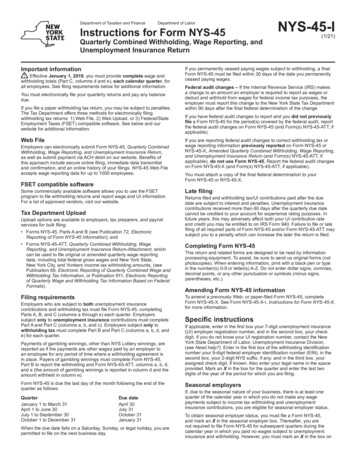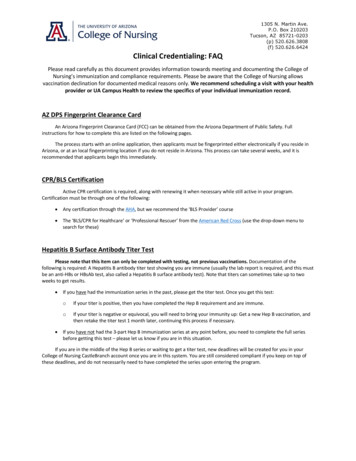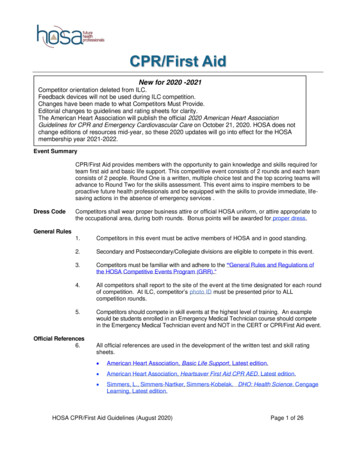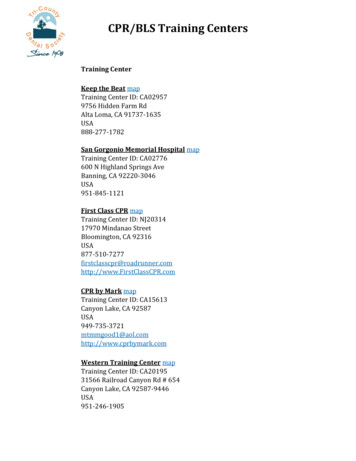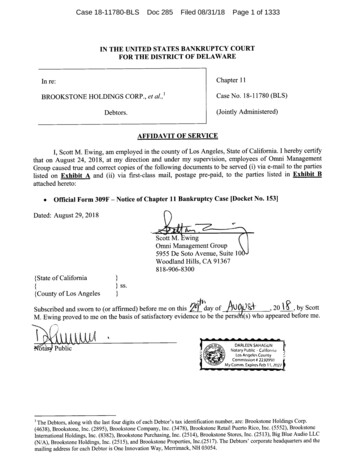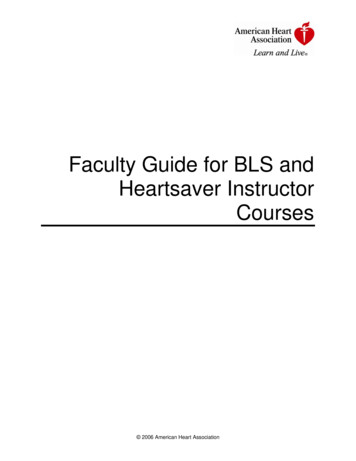
Transcription
Faculty Guide for BLS andHeartsaver InstructorCourses 2006 American Heart Association
ContentsPart 1: Preparing for the Course .3Course Objectives and Competencies.4Course Audience and Prerequisites.4Educational Design .5Faculty Needs .5Attendance Requirements.6Course Planning Checklist and Timeline .6TC Faculty Course Support Materials .10Part 2: Teaching the Course .13Using Lesson Maps.14Cleaning Manikins.15BLS Instructor Course Outline .16Heartsaver Instructor Course Outline.18Part 3: Renewal .20Part 4: Lesson Maps .21BLS Instructor Course Lesson Maps .21Heartsaver Instructor Course Lesson Maps.46Appendix: Instructor Competency Checklist .69 2006 American Heart Association2
Part 1: Preparing for the Course 2006 American Heart Association3
Course Objectives and CompetenciesIntroductionThis manual is to be used by BLS Regional Faculty and Training CenterFaculty to conduct the BLS Instructor Course and the Heartsaver InstructorCourse. Both of these courses are classroom based and are open toinstructor candidates who have met the admission criteria.Course GoalThe American Heart Association designed the BLS Instructor Course andHeartsaver Instructor Course to prepare people to become Basic LifeSupport (BLS) or Heartsaver instructors.ObjectivesAt the end of the BLS Instructor Course or Heartsaver Instructor Course,instructor candidates will be able to teach a BLS course using the video andlesson maps that are part of the appropriate BLS course instructor materials.Instructor candidates will also be able to use the new testing materials toconduct skills testing.Exit CriteriaSuccessful completion of each instructor course consists of instructorcandidates facilitating a session where they Instruct a group on practice-while-watching the video Successfully evaluate another instructor candidate while correctly using theskills testing checklist Successfully remediate another instructor candidateThe Training Center (TC) Faculty will use the American Heart AssociationEmergency Cardiovascular Care Instructor Competency Checklist found atthe end of this manual. This document serves as a guide in assessinginstructor candidate proficiency in the AHA Core Course competenciesduring the practice session in the discipline-specific course. Not allcompetencies can be assessed in a single instructor candidatedemonstration.Course Audience and PrerequisitesWho CanTake theCourseAnyone who wants to become an AHA ECC BLS or Heartsaver instructorcan take this course. The ideal candidate will be motivated to Teach Facilitate learning Ensure that providers acquire the skills necessary for successful coursecompletion View provider assessment as a way to improve individual knowledge andskills 2006 American Heart Association4
CoursePrerequisitesProspective instructors must Have completed the AHA Core Instructor Course Be aligned with an AHA TCThose entering the BLS Instructor Course must have current AHA HealthcareProvider status. Non-healthcare professionals must also have current first aidstatus.Those entering the Heartsaver Instructor Course must have current status inany combination of courses that provide the following skills: Adult/child CPR, AED, mask use, and choking Infant CPR, mask use, and choking First aidEducational DesignLesson-Basedand VideoBasedStructureThe BLS and Heartsaver Instructor Courses are video-based. They aredivided into multiple lessons. Some of the CPR lessons are practice-whilewatching lessons during which students practice skills as the video guidesthem.The video instruction shapes the course. It defines course content and skillspractice intervals and provides consistent instruction to every student inevery class. It should help Training Center Faculty maintain a tight scheduleand a carefully integrated curriculum.This instructional design maximizes skills practice and learning.Practice WhileWatchingThe BLS Instructor Course and Heartsaver Instructor Course are instructorled, using video to guide practice. Immediate TCF feedback during skillspractice enhances learning.Faculty NeedsWho CanTeach theCourseAny current AHA BLS TC or Regional Faculty member may teach the BLS orHeartsaver Instructor Course.TC Faculty-toStudent RatioThe size for each BLS Instructor Course or Heartsaver Instructor Course isflexible, and there is currently no research-based best instructor-to-studentratio. The practice lessons of the course, however, are designed to use a 2006 American Heart Association5
ratio of 8 students to 2 manikins to 1 TC Faculty. This will create 2 groups of4 students. During practice and role-playing sessions, 1 instructor candidatein each group will play the role of instructor and the other 3 will play the roleof students.Attendance RequirementsAttendanceRequirementsInstructor candidates must successfully complete the entire course to beeligible to be monitored as a new instructor. An instructor card is issued onlyafter successful monitoring.Once candidates are certified as instructors, they should be encouraged tojoin the AHA Instructor Network. The Instructor Network is an onlineresource offering a free “one-stop-shop” for access to Instructor and TCCoordinator information, bulletins, and memos, networking and educationalopportunities, and much more.Course Planning Checklist and TimelineNotifying ECCServiceCenter ofPendingCourseTo provide better customer service, the TC should submit a list of plannedinstructor courses that are open to the public to their AHA Service Center.The list should include course dates, location, and contact person forregistration. The Service Center will make this information available to peopleseeking course information.OrderingMaterialsTo help in the distribution of ECC materials, the AHA has partnered withseveral companies that provide high-quality customer service and support.To order materials contact one of the companies listed on the back cover ofany ECC book or visit the ECC website at www.americanheart.org/cpr.Instructors can directly order books or support materials from any of the AHAdistributors. Only a TC Coordinator can order cards.RoomRequirementsYou can teach an average instructor course of 16 instructor candidates with2 TC Faculty in 1 large room. The room should comfortably accommodatethe students with open space at the front of the classroom for manikins,students, chairs, tables, and room to move around easily.The room should have Good acoustics Good lighting that can be dimmed or adjusted for video presentations An instructor-controlled video player (DVD or VCR) and monitor large 2006 American Heart Association6
enough to be viewed by all students. (Although a TV may be acceptable forsmall classes with only a few groups, larger classes with several manikinsmay require a large-screen TV or a TV projector. See the sample floor planon the next page.) Ideally, carpeted floors for skills practice A chair for each student 2006 American Heart Association7
Sample FloorPlanThe following picture shows a sample floor plan:SamplePrecourseLetter toInstructorCandidatesThe letter on the following page is a sample you may modify and send toinstructor candidates. 2006 American Heart Association8
Sample Precourse Letter to Instructor Candidates(Date)DearInstructor Course Candidate:Welcome to theInstructor Course.When and WhereThe class will beDate:Time:Location:Please plan to be on time because it will be hard for late students to catch up once we start.How to Get ReadyInstructor Course covers a lot of material in a short time. Please bringTheyourInstructor Manual(s) and lesson maps with you to class. This will helpyou learn more during the course and make you more comfortable with the material.What to WearPlease wear loose, comfortable clothing. You will be practicing skills that require working onyour hands and knees, bending, standing, and lifting. If you have any physical conditions thatmight prevent these activities, please tell one of the instructors. The instructor may be able toadjust the equipment if you have back, knee, or hip problems. Also please tell your instructor ifyou are allergic to latex.We look forward to welcoming you on(day and date of class) . If youhave any questions about the course, please call (name) at (telephonenumber) .Sincerely,(Title) 2006 American Heart Association9
TC Faculty Course Support MaterialsTC FacultyMaterialsTC Faculty materials available for teaching these courses include thefollowing:ItemTC Faculty Guide for BLSand Heartsaver InstructorCoursesBLS/Heartsaver InstructorCourse DVDsLesson mapsDescriptionText with information abouthow to teach the BLSInstructor Course and theHeartsaver Instructor Course.Available on the InstructorNetwork. Basic Life Support SkillsTesting Training Video 2006 BLS Rollout videotitled: 2006 GuidelinesRollouts Materials TrainingVideos*Cards with information aboutwhat each lesson includesInstructor manuals andManuals and videos (DVD orvideos for all BLS courses VHS format) for all BLScoursesAHA Core InstructorWorkbook and CDWorkbook and CD 2006 American Heart AssociationUseReview before class tounderstand your role and thenecessary equipment Review before class tounderstand the videos Show during class* Note: the 2006 GuidelinesMaterials Training Videos hada mislabeling for the first printrun provided to TCs. Checkthe actual video before usingit in class. Review before class tounderstand your role and thenecessary equipment Refer to these during thecourse to know what eachlesson includes and what youneed to do to help the studentsmeet their learning objectivesfor each lesson Ask students to pull appropriatelesson maps from thesecourses when it is time for roleplay lessons If a student does not have theHeartsaver Instructor Manual,print the necessary lessonmaps from the PDF on theInstructor NetworkRefer to this if students askquestions covered in the AHACore Instructor Course10
EquipmentListThe following table lists the required equipment for the BLS Instructor Courseor the Heartsaver Instructor Course:Quantity1 per candidate1 per set of 4 students(4:1 ratio)1 per course1 per TC Faculty 2006 American Heart AssociationEquipment1-way valve and pocket maskCourse agendaCritical skills testing checklistsSkills practice sheetsCore Instructor Workbook and disciplinespecific manual(s)Student manual for discipline-specificcourseAED trainer with adult padsManikins with shirts: Adult Child (optional) InfantPocket mask (if not enough for 1 perstudent)Stop watchFor BLS instructor course: bag-maskdevices appropriate for manikinsTV with DVD or VCRlaptop or PC with projector and screen (toshow PowerPoint slides)Instructor Course DVD or videotapeAssortment of class DVDs For BLS Instructor Course: HCP; HS FA;HS Pediatric First Aid; or other HS For Heartsaver Instructor: HS First Aid; HSPediatric First Aid; and/or HS AEDCourse rosterManikin cleaning supplies (such as alcoholpads)TC Faculty manual with lesson mapsInstructor CD from discipline-specific course11
UnderstandingIconsThroughout the video and lesson maps, you will see icons that remind you totake certain actions. This approach recognizes that the busy instructor maynot be able to keep track of every important action to take.These icons signal what to do throughout the course:IconActionShow the video.Pause the video for questions and answers.Students practice-while-watching the video.Students practice skills.Discuss the topics listed on the lesson map.Give the written test and skills test. 2006 American Heart Association12
Part 2: Teaching the Course 2006 American Heart Association13
Using Lesson MapsUnderstandingLesson MapsThe AHA 2006 instructor materials include lesson maps to help ourinstructors better facilitate our courses. The lesson maps help ensureconsistency from course to course and help keep the instructor focused onthe main objectives for each lesson. Lesson maps are for instructor use only.Each lesson map represents the main components for that lesson: Course identifier Lesson number Major topics Icon for type of lesson Reference to the student workbook Resources needed Student role Student objectives Instructor role Duration (in minutes)The following graphic is a sample lesson IconContinued on next page 2006 American Heart Association14
Using LessonMapsThere are many ways to use these lesson maps:WhenBefore you teachThen you can:Review the maps to understand: The objectives for each lesson Your role for each lesson The resources that you need for each lessonFollow each lesson map as you conduct the course. Remind students what they will see in each videosegment. Make sure you have all resources and suppliesready for each lesson. Make notes on your lesson maps, such as whatpage numbers in student books to referenceAs you teachCleaning ManikinsManikinCleaningOptionsYou must explain to the instructor candidates how they will clean theirmanikins between students. The following table lists what you should tell thestudent depending on which option you use:OptionFace shieldsAlcohol andgauze Individual faces 2006 American Heart Association Tell the studentsTo put their names on their face shieldTo keep the same side up each time they use the faceshieldIf they are using spray alcohol and gauze, how tospray the alcohol on the gauze, not in the manikinmouth, and to dry the excess alcohol with gauze.If they are using alcohol swabs, how to wipe in andaround the manikin mouth, turn the gauze or swabaround to the clean side and place it over the mouth,and leave it in place for 30 seconds. Then dry theexcess alcohol with gauze.How to keep track of their own manikin face and howto replace the face15
BLS Instructor Course OutlineThe following times are approximate. You may increase times for specific lessons if necessary.Approximate course duration: 5½ hours(Student-TC Faculty ratio 8:1, student-manikin ratio 4:1)LessonCourse EventBLSINSTRUCT1IntroductionBLSINSTRUCT2Overview of New ScienceBLSINSTRUCT3New CPR Course DesignBLSINSTRUCT4Instructor MaterialsBLSINSTRUCT5Outlines of BLS CoursesBLSINSTRUCT6Lesson MapsBLSINSTRUCT7Training FacilitationBLSINSTRUCT8EquipmentBLSINSTRUCT9Room SetupBLSINSTRUCT10Role-Play:Practice While WatchingTimeEstimate(in minutes)522101030571010 2006 American Heart Association40(10 min 4)16
LessonCourse EventBLSINSTRUCT11Skills Testing MethodologyBLSINSTRUCT12Role-Play:Skills TestingBLSINSTRUCT13Written Testing Methodology:BLS for Healthcare ProvidersBLSINSTRUCT14Written Testing Methodology:Heartsaver First Aid and Heartsaver Pediatric First Skills Test RemediationBLSINSTRUCT17Role-Play:Written Test RemediationBLSINSTRUCT18TC SpecificsBLSINSTRUCT19Course MonitoringBLSINSTRUCT20Instructor RenewalBLSINSTRUCT21Self-Directed Learning and Blended TrainingTimeEstimate(in minutes)2540(10 min 4)105540(10 min 4)1530155 2006 American Heart Association517
Heartsaver Instructor Course OutlineMake changes to this outline to match the HCP Instructor OutlineThe following times are approximate. You may increase times for specific lessons if necessary.Approximate course duration: 5½ hours(Student-TC Faculty ratio 8:1, student-manikin ratio 4:1)LessonCourse EventHSINSTRUCT1IntroductionHSINSTRUCT2Overview of New ScienceHSINSTRUCT3New CPR Course DesignHSINSTRUCT4Instructor MaterialsHSINSTRUCT5Outlines of HS CoursesHSINSTRUCT6Lesson MapsHSINSTRUCT7Training FacilitationHSINSTRUCT8EquipmentHSINSTRUCT9Room SetupHSINSTRUCT10Role-Play:Practice While WatchingTimeEstimate(in minutes)522101030571010 2006 American Heart Association40(10 min 4)18
LessonCourse EventHSINSTRUCT11Skills Testing MethodologyHSINSTRUCT12Role-Play:Skills TestingHSINSTRUCT13Written Testing Methodology:Heartsaver First Aid and Heartsaver Pediatric First ills Test RemediationHSINSTRUCT16TC SpecificsHSINSTRUCT17Course MonitoringHSINSTRUCT18Instructor RenewalHSINSTRUCT19Self-Directed Learning and Blended TrainingTimeEstimate(in minutes)2510 45540(10 min 4)30155 2006 American Heart Association519
Part 3: RenewalInstructorRenewalCriteriaThere is no renewal version of this course. If you offer a “renewal course,”use the full agenda listed earlier in this manual. See the ProgramAdministration Manual and Instructor Network for renewal requirements. 2006 American Heart Association20
Part 4: Lesson MapsBLS Instructor Course Lesson Maps 2006 American Heart Association21
0:00START Welcome3:00RESOURCES:STUDENT ROLE: Introduce self Listen to instructorSTUDENT OBJECTIVES:YOUR ROLE: Introduce instructors Invite participants to introducethemselves Explain housekeeping issues, includingrestrooms Explain paperwork Explain how students will learn byinstructor-led discussions, practice-whilewatching lessons, and practice sessions Tell the students:“We are scheduled to end at .”REFERENCE:none
BLSINSTRUCT10:00IntroductionRESOURCES:5:00YOUR ROLE: Introduce concepts of new courses Motivate instructors to teach using newmethodologySTUDENT ROLE: Listen to TC facultySTUDENT OBJECTIVES: Get motivated to be an AHAinstructorREFERENCE:Instructor Manual
BLSINSTRUCT20:00Overview of New ScienceRESOURCES: AV equipment Overview of Science video (Note:In the future, this video may beomitted and other science updatesmay need to be included.)STUDENT ROLE: Watch videoSTUDENT OBJECTIVES: List the key changes toscience in AHA 200522:00YOUR ROLE: Evaluate instructor candidates to establishneed for in-depth Overview of Science video Introduce video:“This video will overview the new sciencein Guidelines 2005.” Show BLS Science Update on Overview ofScience video Refer students to Currents in EmergencyCardiovascular Care Winter 2005 issue andAHA 2005 Guidelines for CPR and ECC Answer questionsGuidelines for CPR and ECCthat affect the BLS coursesREFERENCE:Instructor Manual, Currents in Emergency Cardiovascular CareWinter 2005, AHA 2005 Guidelines for CPR and ECC
BLSINSTRUCT30:00New CPR Course DesignRESOURCES: AV equipment A New Way to Teach CPR videoSTUDENT ROLE: Watch video10:00YOUR ROLE: Introduce video:“This section of the video will explain themajor changes to CPR course design andimplementation based on educationalresearch.” Show New Course Design presentationon A New Way to Teach CPR video Answer questionsSTUDENT OBJECTIVES: List the major changes to CPRcourse design andimplementation based oneducational researchREFERENCE:Instructor Manual
BLSINSTRUCT40:00Instructor MaterialsRESOURCES: Instructor materialsSTUDENT ROLE: Listen to TC facultySTUDENT OBJECTIVES:10:00YOUR ROLE: Orient the students to the instructormaterials and how to use each piece ־ Instructor manual ־ Instructor CD ־ Course outline ־ Course agenda ־ Course videos ־ Lesson maps Answer questions List the main parts of theinstructor materials for eachBLS courseREFERENCE:Instructor Manual
BLSINSTRUCT50:00Outlines of BLS CoursesRESOURCES: BLS Course Overview PowerPointpresentation BLS HCP course outline Heartsaver Pediatric First Aidcourse outlineSTUDENT ROLE: Listen to TC facultySTUDENT OBJECTIVES: Know how to use the courseoutlines to guide teaching a course30:00YOUR ROLE: Show BLS Course Overview PowerPointpresentation to explain each of thecourses and what the instructors canteach Refer students to BLS HCP andHeartsaver Pediatric First Aid courseoutlines in instructor manuals Pass out Heartsaver Pediatric First Aidcourse agenda and outline to anyinstructor who does not have aHeartsaver Instructor Manual Explain how to use the course outlinesREFERENCE:Instructor Manual
BLSINSTRUCT60:00Lesson MapsRESOURCES: AV equipment A New Way to Teach CPR videoSTUDENT ROLE: Watch video5:00YOUR ROLE: Introduce video:“This section of the video introduces you tolesson maps, an instructor tool to help youteach courses.” Show Lesson Maps presentation on ANew Way to Teach CPR video Pause video Answer questionsSTUDENT OBJECTIVES: Understand the layout of thelesson mapsREFERENCE:Instructor Manual
BLSINSTRUCT70:00Training FacilitationRESOURCES: AV equipment A New Way to Teach CPR videoSTUDENT ROLE: Watch video7:00YOUR ROLE: Introduce video:“This section of the video explains how tofacilitate AHA courses.” Show Training Facilitation presentationon A New Way to Teach CPR video Pause video Answer questionsSTUDENT OBJECTIVES: Understand how to facilitate AHAcoursesREFERENCE:Instructor Manual
BLSINSTRUCT80:00EquipmentRESOURCES: AV equipmentBLS HCP instructor manualHeartsaver instructor manualManikinsFace shieldsFace masks1-way valvesSTUDENT ROLE: Listen to TC faculty Ask questionsSTUDENT OBJECTIVES: Tell how to find what equipment acourse needs Tell where to find equipment Tell how to clean and storeequipment10:00YOUR ROLE: Explain where to find lists of required andrecommended equipment in disciplinespecific instructor manual Explain how the participant-manikin ratiowill affect the quantity of manikins, facemasks, and other supplies Answer questions Explain how instructors will instructstudents to clean equipment duringcourse Explain how instructors will cleanequipment after each courseREFERENCE:Instructor Manual
BLSINSTRUCT9A0:00Room SetupRESOURCES: AV equipment BLS HCP instructor manual Heartsaver instructor manualSTUDENT ROLE: Listen to TC faculty Ask questions10:00YOUR ROLE: Tell students to turn to sample floor planfor CPR training picture in BLS HCPinstructor manual or Heartsaver instructormanual Explain why it is critical to set up theroom appropriately Discuss what-if situations for instructorcandidates to solveSTUDENT OBJECTIVES: Tell how to set up the room tomaximize student learningREFERENCE:Instructor Manual
BLSINSTRUCT Room SetupDiscussion Details9BSample Floor Plan for CPR TrainingSample What-If Scenarios If a classroom is long and narrow If a classroom has support pillars in the middle
BLSINSTRUCT Role-Play:Practice-While-Watching10ARESOURCES: AV equipmentAdult manikinsFace shieldsLesson maps from BLS HCP andHeartsaver Pediatric First Aid Epinephrine pen trainers BLS HCP video Heartsaver Pediatric First Aid videoSTUDENT ROLE: Watch video Practice while watching 1 student serves as instructor40:00YOUR ROLE: Remind students of ratios and break students intosmall groups Select 1 student to serve as first instructor in eachgroup of 4 students Tell students to pull lesson maps from the courselesson maps for the subsequent role-playing (use thegrid on the following lesson map) or provide copies ofthe specific lesson maps Rotate among all students with each practicing asinstructor using lesson maps and video “Teaching” student observes students and givespositive and corrective feedback TCF gives “teaching” student positive and correctivefeedbackSTUDENT OBJECTIVES: Practice facilitating lessons Show how to use lesson maps0:00REFERENCE:Instructor Manual
t t 1Student 2Student 3Student 4Act as instructorShow videoFacilitateObserve studentsand give feedback Act as student Watch video Practice with video Act as student Watch video Practice with video Act as student Watch video Practice with video Act as student Watch video Practice with video Act as student Watch video Practice with video Act as student Watch video Practice with video Act as student Watch video Practice with video Act as student Watch video Practice with video Act as student Watch video Practice with video Act as student Watch video Practice with video Act as student Watch video Practice with video Act as student Watch video Practice with video Act as instructorShow videoFacilitateObserve studentsand give feedbackAct as instructorShow videoFacilitateObserve studentsand give feedback Act as instructorShow videoFacilitateObserve studentsand give feedback
BLSINSTRUCT110:00Skills Testing MethodologyRESOURCES: AV equipmentSkills Testing videoSkills checklistsStopwatchesSTUDENT ROLE: Watch video Participate with the video25:00YOUR ROLE: Introduce video: “This section of the video will explain howto perform skills testing.”Show Skills Testing videoPause videoAnswer questionsStress the importance of instructorstudent-manikin ratiosSTUDENT OBJECTIVES: Tell how to perform skills testingREFERENCE:Instructor Manual
BLSINSTRUCT Role-Play:Skills Testing0:0012RESOURCES: AV equipmentAdult manikinsFace shieldsStopwatchesSkills checklistsSTUDENT ROLE: Watch student performing CPR Use skills checklist to test studentSTUDENT OBJECTIVES: Correctly use skills checklist Show how to use stopwatch40:00YOUR ROLE: 1 instructor candidate performs adultCPR as a student, making somemistakes Refer students to Adult CPR Practice andTest lesson map Tell all students to use skills checklist torecord “student’s” performance Review skills checklist based on“student’s” performance Discuss students’ checklists Answer questionsREFERENCE:Instructor Manual
BLSINSTRUCT Written Testing Methodology:BLS for Healthcare Providers13RESOURCES: AV equipmentBLS HCP written testBLS HCP annotated answer sheetAnswer keySTUDENT ROLE: Watch presentation10:00YOUR ROLE: Introduce topic:“This section of the course will explain howto perform written testing for the BLS HCPcourse.” Pass out written tests, annotated answersheets, and answer keys Tell students how to administer writtentests Answer questionsSTUDENT OBJECTIVES: Tell where to find testsTell how to administer testsTell how to grade testsTell how to score tests0:00REFERENCE:Instructor Manual
BLSWritten Testing Methodology:INSTRUCTHeartsaver First Aid andHeartsaver Pediatric First Aid14RESOURCES: AV equipmentHS FA student workbookHS FA answer sheetHS FA 8 lesson mapSTUDENT ROLE: Watch presentationSTUDENT OBJECTIVES: Tell where to find tests Tell how to administer tests0:005:00YOUR ROLE: Introduce topic:“This section of the course will explain howto perform written testing for theHeartsaver first aid courses.” Tell students to turn to HS FA 8 lessonmap – First Aid Basics Test Pass out answer sheets Tell students how to administer writtentests Remind students that there is no pass/failfor this test Answer questionsREFERENCE:Instructor Manual
BLSINSTRUCT150:00RemediationRESOURCES: AV equipment ECC Core Instructor Course,Evaluation unitSTUDENT ROLE:5:00YOUR ROLE: Introduce video:“This section of the video will explain howto perform remediation.” Show Remediation video Pause video Answer questions Watch presentationSTUDENT OBJECTIVES: Tell how to perform remediationREFERENCE:Instructor Manual
BLSINSTRUCT Role-Play:Skills Test Remediation16RESOURCES: Adult manikinsFace shieldsStopwatchesSkills checklistsSTUDENT ROLE: Remediate student40:00YOUR ROLE: Tell students to remediate student whoshowed poor skills during testing roleplay Use skills checklist to record student’sperformance Review skills checklist based on“student’s” performance Discuss students’ checklists Have students pair up Answer questionsSTUDENT OBJECTIVES: Show how to use skills checklist Show how to use stopwatch0:00REFERENCE:Instructor Manual
BLSINSTRUCT Role-Play:Written Test Remediation17RESOURCES: BLS HCP written test15:00YOUR ROLE: Tell students to pair up and take turnsremediating the BLS HCP written test “Instructor” discusses missed questionwith partner to ensure the studentunderstands the conceptSTUDENT ROLE: Remediate studentSTUDENT OBJECTIVES: Show how to remediate writtentest0:00REFERENCE:Instructor Manual
BLSINSTRUCT180:00Training Center SpecificsRESOURCES:STUDENT ROLE: Listen to TC facultySTUDENT OBJECTIVES: Tell training center specifics forrunning courses30:00YOUR ROLE: Tell students issues specific to yourtraining center: Course completion cards Course evaluations How to get tests Updates Registering on the AHA InstructorNetwork Staying in touch with your trainingcenter Post-course paperwork Answer question
Provider status. Non-healthcare professionals must also have current first aid status. Those entering the Heartsaver Instructor Course must have current status in any combination of courses that provide the following skills: Adult/child CPR, AED, mask use, and choking Infant CPR, mask use, an



